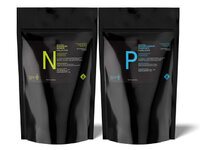Cody
Vice President
Staff member
Administrator
Moderator
Content Moderator
Board Member
Supporting Member
So I have struggled with low phosphates in the past and always dosed Brightwell's NeoPhos, which is great! I love their products, the concentrations are consistent, and the calculating equations they provide are accurate! However, you can cruise through them quickly and it adds up on larger/multiple systems. So, I purchased some dry powder a few months ago to make my own solution. Flash forward to today when I spent the time to try and dial in the proportions and how much it would raise the PO4 in my tank.
I have always used Green Leaf Aquariums nitrate powder to make my own dosing solution, so I figured I'd give their phosphate one a try as well. Brightwell NeoPhos raises the PO4 of 1 gallon of water about .25ppm, so I wanted a similar concentration, for a few reasons, that's easy to measure and mix. What I found is that 1/2 TSP (3 grams) of the Green Leaf PO4 powder mixed with one gallon (3.785 Liters) of RO/distilled water makes for a concentration that raises one gallon of water by .16ppm, which is great! It's significant enough to not have to dose a bunch, easy to measure and mix, and allows you a little more flexibility in situations where you need to raise it slower or have a smaller tank. Not to mention, a single $5 one pound bag can make about 115 gallons of dosing solution, versus the $11 for 500mL price for Brightwell.
The dosing calculation is this:
(ppm to raise parameter / .16) x water volume in gallons
That tells you how much to dose in mL. Pretty easy once you dial it in.

I have always used Green Leaf Aquariums nitrate powder to make my own dosing solution, so I figured I'd give their phosphate one a try as well. Brightwell NeoPhos raises the PO4 of 1 gallon of water about .25ppm, so I wanted a similar concentration, for a few reasons, that's easy to measure and mix. What I found is that 1/2 TSP (3 grams) of the Green Leaf PO4 powder mixed with one gallon (3.785 Liters) of RO/distilled water makes for a concentration that raises one gallon of water by .16ppm, which is great! It's significant enough to not have to dose a bunch, easy to measure and mix, and allows you a little more flexibility in situations where you need to raise it slower or have a smaller tank. Not to mention, a single $5 one pound bag can make about 115 gallons of dosing solution, versus the $11 for 500mL price for Brightwell.
The dosing calculation is this:
(ppm to raise parameter / .16) x water volume in gallons
That tells you how much to dose in mL. Pretty easy once you dial it in.













